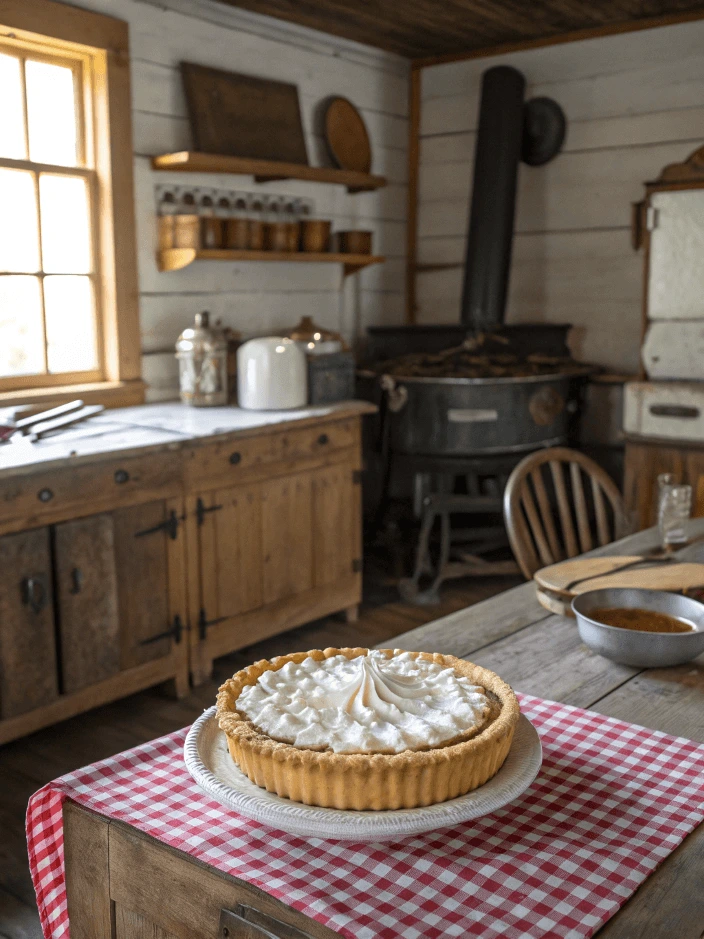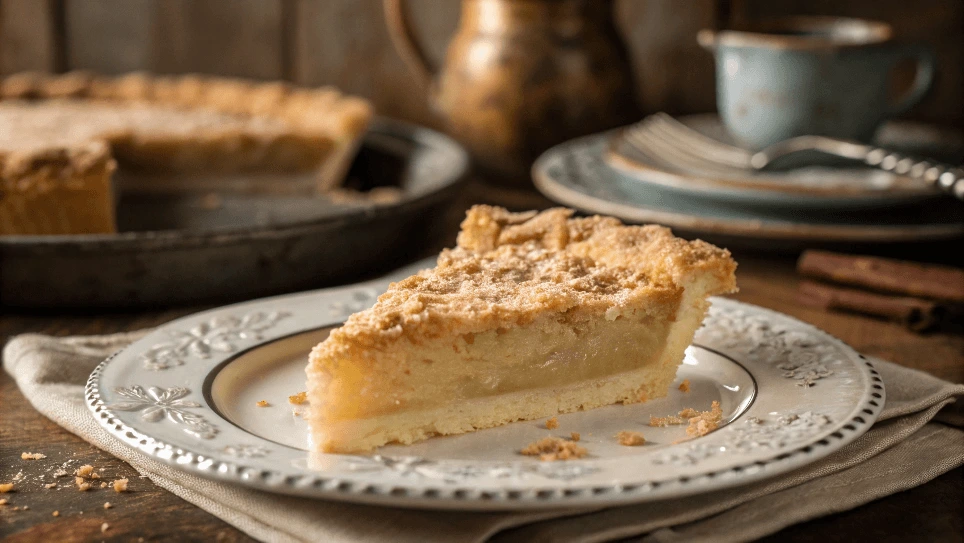Have you ever heard of a pie made with just water, sugar, and butter? It sounds almost too simple to be true! Yet, during tough times, people created ingenious desserts from the bare essentials. That’s exactly how water pie was born. But where did water pie originate? This humble dessert traces back to a time when families had to be creative with whatever ingredients they had. With just a few pantry staples, they turned basic items into something warm, sweet, and comforting.
Water pie isn’t just a recipe—it’s a piece of history on a plate. First, it’s incredibly easy to make. Next, it has a light, buttery flavor that melts in your mouth. Plus, it’s budget-friendly, making it perfect for any home baker. If you love simple, nostalgic desserts, this is one you’ll want to try. So, let’s dive in and uncover its fascinating past!
Table of Contents
The Origins of Water Pie

How Water Pie Became a Great Depression Staple
Water pie is one of those fascinating, old-fashioned desserts that emerged out of necessity. It was created during the Great Depression, a time when families had to stretch every ingredient. Instead of using milk, eggs, or fancy fillings, home bakers relied on basic pantry staples to make a simple yet satisfying pie.
During this period, food scarcity was a daily challenge. Many families couldn’t afford fresh dairy or expensive ingredients. But they still craved something sweet. So, they got creative! By combining water, sugar, butter, and flour, they developed a pie that had a light, custard-like texture with a delicate, buttery sweetness.
The beauty of water pie lies in its simplicity and affordability. The ingredients were always on hand, making it a reliable dessert option. Even though it started as a survival food, its soft, melt-in-your-mouth texture made it a favorite for generations.
Here’s why water pie was perfect for hard times:
| Reason | How It Helped During the Depression |
|---|---|
| Few Ingredients | Made with pantry staples only |
| No Dairy Needed | No milk or eggs required |
| Budget-Friendly | Extremely low-cost dessert |
| Easy to Make | Quick and simple recipe |
Even today, water pie remains a nostalgic treat. It reminds people of resilience and resourcefulness, proving that delicious food doesn’t have to be complicated.
Who First Made Water Pie?
The exact origin of water pie is hard to pinpoint. However, it is closely linked to Southern cooking traditions and Depression-era ingenuity. Many believe that Southern families first made it, passing down the recipe through generations.
Water pie was common in regions where flour, sugar, and butter were household staples. Instead of wasting ingredients, home bakers figured out a way to make something sweet with the bare minimum. The simplicity of this pie made it accessible to everyone, regardless of wealth or resources.
Let’s break down the key factors that led to water pie’s creation:
| Factor | Impact on Water Pie’s Origin |
|---|---|
| Southern Influence | Rooted in resourceful Southern cooking traditions |
| Economic Hardship | Created due to financial struggles |
| Ingredient Availability | Made with pantry staples found in most homes |
| Pass-Down Tradition | Recipe was shared across generations |
Many families have their own slight variations of the recipe. Some add vanilla, cinnamon, or nutmeg for extra flavor, while others keep it as simple as possible. Regardless of how it’s made, water pie’s history is a testament to resilience and creativity.
Would you have tried this pie if you were living during that time? It’s amazing how people made the most of what they had—and ended up creating something delicious!
If you’re curious about how this Depression-era pie is made, check out this water pie recipe and try baking a slice of history!
Why Was Water Pie Created?
The Role of Scarcity in Depression-Era Cooking
Water pie was born out of necessity, not luxury. During the Great Depression, food was scarce, and families had to make every ingredient count. Many people couldn’t afford milk, eggs, or fresh produce, so they relied on whatever pantry staples they had.
Sugar, butter, flour, and water were affordable and readily available, making them essential in budget-friendly cooking. Home bakers experimented with these basic ingredients, creating simple but comforting meals. Water pie was a result of that creativity—it provided a touch of sweetness without requiring expensive ingredients.
Another reason for its creation was food rationing. Many ingredients were limited, so families had to find ways to stretch their supplies. Instead of traditional custard pies that needed eggs and milk, they used water as the base and let butter and sugar bring out the flavor.
Here’s why water pie became a go-to dessert:
| Reason | Impact on Water Pie’s Creation |
|---|---|
| Ingredient Shortages | No access to milk, eggs, or fresh produce |
| Budget Constraints | Families needed the cheapest meals possible |
| Creative Solutions | Home bakers found new ways to make desserts |
| Food Rationing | Limited access to essential baking ingredients |
Despite being created during hard times, water pie has stood the test of time. Today, it’s enjoyed for its nostalgic charm and simplicity, reminding us how resourcefulness can lead to delicious creations.
How Families Used Simple Ingredients to Survive
Families in the Great Depression became experts at making do with what they had. Instead of wasting ingredients, they found smart ways to stretch their food supply. Water pie was one of many creative recipes that emerged during this time.
Since fresh dairy and eggs were expensive, people turned to shelf-stable ingredients. They made broths from vegetable scraps, stretched flour with cornstarch, and even used vinegar as a milk substitute. Desserts like water pie were valuable because they provided comfort without requiring costly ingredients.
Here’s how families maximized their food supplies during tough times:
- Using Water Instead of Milk: Water helped create custard-like textures in pies.
- Making Butter Last Longer: Small amounts of butter were spread across multiple recipes.
- Using Sugar Wisely: Sugar was carefully measured to stretch across meals.
- Baking Without Eggs: Many recipes replaced eggs with alternative binders like flour and water.
- Reusing Ingredients: Families saved and reused everything, from bacon grease for cooking to stale bread for puddings.
Ingredient Substitutions During the Great Depression:
| Common Ingredient | Depression-Era Substitute |
|---|---|
| Milk | Water or vinegar + baking soda |
| Eggs | Flour + water mixture or applesauce |
| Sugar | Honey or molasses |
| Butter | Lard or shortening |
Water pie wasn’t the only creative dessert from this era. Families also made mock apple pie, sugarless cakes, and potato biscuits. These dishes prove that even in difficult times, people found joy in simple, homemade treats.
Want to make sure your pie turns out perfect? Learn how to keep the bottom of a pumpkin pie from getting soggy—a tip that works for water pie too!
The next time you take a bite of water pie, remember—it’s more than just a dessert. It’s a symbol of resilience, creativity, and the power of making the most of what you have!
Water Pie’s Regional and Cultural Influence
Is Water Pie a Southern Invention?
Water pie is often associated with Southern cooking traditions, but its exact origin remains a mystery. Many believe it was created in rural Southern communities, where families relied on simple, affordable ingredients to make comforting meals. The South has a long history of resourceful cooking, making water pie a natural fit.
During the Great Depression, Southern households often had butter, sugar, flour, and water—the main ingredients of water pie. While other regions also faced hardships, the South was particularly known for creative, no-waste recipes. Dishes like cornbread, biscuits, and fruit cobblers were common, using whatever was available.
Another reason water pie is linked to the South is its similarity to chess pie. Both desserts use basic pantry ingredients, but chess pie contains eggs and cornmeal, making it richer. Water pie, however, remains lighter and silkier, reflecting the “make-do” mentality of the time.
Here’s how water pie compares to other Southern staple desserts:
| Dessert | Key Ingredients | Texture & Flavor |
|---|---|---|
| Water Pie | Water, sugar, butter, flour | Light, buttery, custard-like |
| Chess Pie | Eggs, sugar, cornmeal, butter | Rich, dense, caramel-like |
| Buttermilk Pie | Buttermilk, eggs, sugar, flour | Tangy, creamy, custard-based |
| Sugar Cream Pie | Heavy cream, sugar, butter | Smooth, sweet, creamy |
The Southern influence on water pie is undeniable. Whether it was first baked in the Deep South or elsewhere, one thing is certain—its humble, comforting flavors make it a true classic.
Water pie wasn’t the only creative dessert from this era. People also made simple treats like vegetarian cinnamon sugar donut muffins, proving that even in difficult times, homemade sweets brought comfort.
Similar Desserts From Other Hardship Periods
Water pie wasn’t the only dessert created out of hardship and scarcity. Throughout history, people have found ways to make delicious treats with limited ingredients.
During the Great Depression, families made mock apple pie using crackers instead of apples. In World War II, sugar was rationed, so bakers made wartime cakes using honey or molasses instead. Even earlier, pioneers made hoe cakes, a simple flatbread cooked over an open fire.
Here are some other famous desserts born from difficult times:
- Mock Apple Pie – Made with crackers instead of apples, flavored with cinnamon and sugar.
- Wacky Cake – A chocolate cake made without eggs, milk, or butter.
- Sugar Cream Pie – A Midwestern classic using sugar, cream, and flour.
- Potato Doughnuts – Made with mashed potatoes to stretch the batter.
Hardship-Era Desserts and Their Key Ingredients:
| Dessert Name | Time Period | Main Ingredients |
|---|---|---|
| Water Pie | Great Depression | Water, sugar, butter, flour |
| Mock Apple Pie | Great Depression | Crackers, cinnamon, sugar |
| Wartime Cake | WWII Rationing | Flour, cocoa, honey |
| Hoe Cakes | Pioneer Era | Cornmeal, water, salt |
| Potato Doughnuts | Early 1900s | Mashed potatoes, flour |
These desserts show that even in the toughest times, people found ways to create comfort through food. Water pie may have originated during the Great Depression, but its spirit of creativity and resilience lives on.
Would you try any of these historical desserts? It’s amazing how people turned simple ingredients into something sweet and special!
How Water Pie Became a Nostalgic Dessert
The Revival of Water Pie in Modern Times
Water pie was once a forgotten recipe, but today, it’s making a major comeback. Many people are rediscovering this simple yet comforting dessert, either through family recipes or curiosity about history. The nostalgia surrounding water pie plays a big role in its revival.
First, modern home bakers love how easy and affordable it is to make. With just a few pantry staples, anyone can create a silky, buttery dessert without spending much. In addition, many people enjoy the historical connection, knowing that this pie represents resilience and creativity during difficult times.
Another reason for its return is the rise of vintage cooking trends. People are bringing back old-fashioned recipes, from Depression-era meals to wartime baking. Water pie fits perfectly into this trend, offering a taste of the past with a fun, modern twist.
Here’s why water pie is gaining popularity again:
| Reason | Why It Appeals to Modern Bakers |
|---|---|
| Budget-Friendly | Uses basic ingredients found in every kitchen |
| Easy to Make | No special skills or fancy equipment needed |
| Unique History | Offers a taste of the Great Depression era |
| Nostalgia Factor | Reminds people of family traditions and simpler times |
Thanks to its simplicity and fascinating backstory, water pie is no longer just a survival dessert. Instead, it has become a beloved piece of history, reminding people of the power of creativity in the kitchen.
How Social Media Brought Water Pie Back
Social media has played a huge role in reviving water pie. Platforms like TikTok, Instagram, and YouTube have introduced this forgotten dessert to a new generation of bakers. Suddenly, a pie that was once a symbol of survival has become a trendy viral sensation.
The appeal of water pie on social media comes from its unexpected simplicity. People love trying recipes with unusual origins, and the fact that it uses water as a main ingredient intrigues viewers. In addition, the pie’s buttery, melt-in-your-mouth texture makes it visually appealing, especially in recipe videos.
Here’s how social media has helped water pie go viral:
- TikTok Challenges: Home bakers share their first reactions to tasting water pie.
- YouTube Tutorials: Cooking channels teach people how to make this Depression-era dessert.
- Instagram Reels: Beautifully shot videos showcase the pie’s creamy texture.
- Facebook Groups: People discuss and share family recipes with nostalgic stories.
Social Media’s Influence on Water Pie’s Popularity:
| Platform | How It Helped Water Pie Trend |
|---|---|
| TikTok | Viral baking challenges & first-reaction videos |
| YouTube | Step-by-step tutorials reaching millions |
| High-quality food photography & reels | |
| Nostalgic discussions & family recipe sharing |
Social media hasn’t just brought water pie back—it has made it cool again. Whether people bake it for fun, history, or nostalgia, this simple dessert has found a new audience eager to keep the tradition alive.
Would you try making water pie after seeing it online? The internet has turned this humble dish into a global sensation, proving that even the simplest recipes can capture hearts!
Frequently Asked Questions (FAQs)
Where is water pie from?
Water pie is believed to have originated in Southern kitchens during the Great Depression. Families needed a simple, budget-friendly dessert, so they used pantry staples like water, sugar, butter, and flour. This pie became a symbol of creativity in tough times. Today, it’s a nostalgic favorite, reminding people how resourcefulness can turn basic ingredients into something delicious.
Where did shoofly pie originate?
Shoofly pie comes from the Pennsylvania Dutch community in the United States. It was created in the 1800s using molasses, sugar, and a crumbly topping. This pie has a rich, deep sweetness, almost like a cake inside a crust. The name comes from how the sweet molasses attracted flies! It remains a beloved Amish and Mennonite dessert enjoyed to this day.
Where did pie originally come from?
Pie has been around for thousands of years! The ancient Egyptians were among the first to bake savory-filled pastries. Then, the Romans spread pie-making across Europe, adding sweet and savory variations. During the Middle Ages, pies became popular in England before making their way to America. Over time, pie evolved into a classic dessert enjoyed worldwide, with endless flavors and styles.
Where did flapper pie originate?
Flapper pie is a Canadian classic that originated in the Prairie provinces. This creamy, custard-filled pie became popular in the 1920s, when ingredients like graham crackers, eggs, and sugar were common. The name “flapper” reflects the roaring ‘20s era when it was created. Today, it remains a nostalgic favorite, known for its sweet vanilla custard, graham crust, and fluffy meringue topping.
Conclusion: The Legacy of Water Pie
Water pie is more than just a dessert—it’s a reminder of resilience and creativity in tough times. But where did water pie originate? It came from a time when people had to stretch ingredients and make do with what they had. First, it started as a necessity. Then, it became a symbol of resourcefulness that families passed down through generations.
Today, water pie is more than a survival dish. It has become a nostalgic favorite, connecting people to the past while remaining simple and delicious. Social media has also helped revive its popularity, bringing this once-forgotten recipe back into kitchens everywhere.
If you’ve never tried water pie, why not bake one? It’s an easy, fun way to experience history on a plate. Who knew something so simple could hold so much meaning? Now, it’s your turn to keep the tradition alive!

